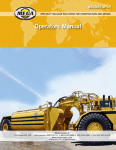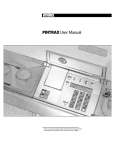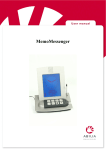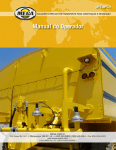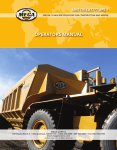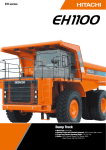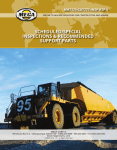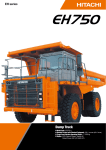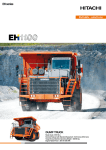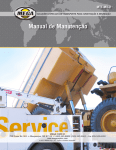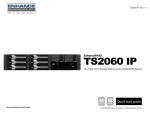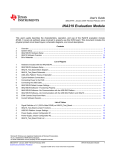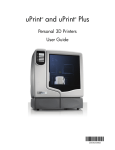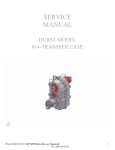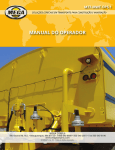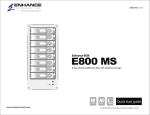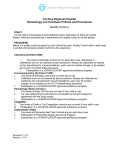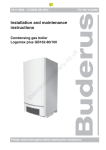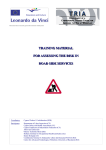Download Operators Manual
Transcript
MES34-OPS-1 SPECIALTY HAULAGE SOLUTIONS FOR CONSTRUCTION AND MINING Operators Manual MEGA CORP.® 700 Osuna Rd. N.E. • Albuquerque, NM 87113 • 1-800-345-8889 • 505-345-2661 • Fax 505-345-6190 www.megacorpinc.com ® MEGA Corp., Inc. All Rights Reserved MES34-OPS-1 21 Feb 2014 TABLE OF CONTENTS Page Section 1 Definitions and Abbreviations . . . . . . . . . . . . . . . . . . . . . . . . . . . . . . . . . . . . . . . . . . . . . . . . .1-1 Section 2 System Description. . . . . . . . . . . . . . . . . . . . . . . . . . . . . . . . . . . . . . . . . . . . . . . . . . . . . . . . . . . .2-1 Section 3 Limitations . . . . . . . . . . . . . . . . . . . . . . . . . . . . . . . . . . . . . . . . . . . . . . . . . . . . . . . . . . . . . . . . . . . .3-1 Section 4 Normal Operations . . . . . . . . . . . . . . . . . . . . . . . . . . . . . . . . . . . . . . . . . . . . . . . . . . . . . . . . . . . .4-1 Section 5 Performance . . . . . . . . . . . . . . . . . . . . . . . . . . . . . . . . . . . . . . . . . . . . . . . . . . . . . . . . . . . . . . . . . .5-1 Section 6 MES34 Operator’s Checklist. . . . . . . . . . . . . . . . . . . . . . . . . . . . . . . . . . . . . . . . . . . . . . . . . . . .6-1 A MES34-OPS-1 21 Feb 2014 TABLE OF CONTENTS B (Blank) MES34-OPS-1 21 Feb 2014 SECTION 1 Definitions and Abbreviations Contents Manual Usage....................................................................1-1 Warning, Caution And Notes .......................................1-1 Use Of Shall, Will, Should And May............................1-1 Safety Messages ...............................................................1-2 Abbreviations....................................................................1-3 MES34 Overview (Typical) ............................................1-4 MANUAL USAGE WARNING, CAUTION AND NOTES This technical manual only contains information required to safely install or service an MES34 elevator scraper system. See the CAT 631 Operator’s Safety Manual for tractor specific system information and operating procedures. If your system is not covered in this manual or you are experiencing difficulties, please contact MEGA Corp. Product Support Group at: US toll free: 1-800-345-8889, Direct: 1-505-3452661 or visit our website at www.megacorpinc.com for more detailed contact information. The following definitions are found throughout the manual and apply as follows: Operating procedures and techniques, which could result in personal injury and/or loss of life if not carefully followed. Operating procedures and techniques, which could result in damage to equipment if not carefully followed. The exact location of the hazards and description of the hazards are reviewed in this section. All personnel working on or operating the machine must become familiarized with all the safety messages. Operating procedures and techniques that are considered essential to emphasize. Due to the nature of these processes, ensure that all safety information, warnings and instructions are read and understood before any operation or any maintenance procedures are performed. Some procedures take place with heavy components and at moderate heights, ensure proper safety procedures are maintained when performing these actions. Failure to use and maintain proper safety equipment and procedures will cause injury, death or damage to equipment. USE OF SHALL, WILL, SHOULD AND MAY Shall and Will – Used when application of a procedure is mandatory. Should – Used when application of a procedure is recommended. May - Used to indicate an acceptable or suggested means of accomplishment. 1-1 MES34-OPS-1 21 Feb 2014 SECTION 1 Definitions and Abbreviations SAFETY MESSAGES BACKING RUNOVER HAZARD (2) This safety label is located on the rear of the scraper and inside the cab. There are several specific safety messages on this machine. The exact location of the hazards and description of the hazards are reviewed in this section. All personnel working on or operating the machine must become familiarized with all the safety messages. Make sure that all of the safety messages are legible. Clean the safety messages or replace the safety messages in you cannot read the words. Replace the illustrations if the illustrations are not legible. When you clean the safety messages, use a cloth, water and soap. Do not use solvent, gasoline or other harsh chemicals to clean the safety messages. Solvents, gasoline or harsh chemicals could loosen the adhesive that secures the safety messages. Loose adhesive will allow the safety messages to detach. The vehicle is equipped with a back-up alarm. Alarm must sound when operating this vehicle in reverse. Failure to maintain a clear view in the direction of travel could result in serious injury or death. Replace any safety message that is damaged or missing. If a safety message is attached to a part that is replaced, install a new safety message on the replacement part. FALL HAZARD (3) This safety label is located at the top of the scraper. DO NOT OPERATE (1) This safety label is located on the outside of the cab. Do not open this control box unless you read and understand the instructions and warnings in the Operator and Maintenance Manual. Failure to follow instructions or heed the warnings could result in serious injury or death. Ensure PPE fall arrest harness is worn, adjusted properly and attached to an anchor point when performing maintenance on top of the MES34 or when fall hazards are present. Failure to use PPE when fall hazards are present may result in serious personnel injury or death. 1-2 MES34-OPS-1 21 Feb 2014 SECTION 1 Definitions and Abbreviations ABBREVIATIONS HIGH PRESSURE MOTOR (4) This safety label is located on the hydraulic motor. ft - feet fpm - feet per minute gpm - gallons per minute GET - Ground Engaging Tools KM-H - Kilometers Hour Kg - kilograms l - liters lpm - liters per minute LT - Left M - meters MES - MEGA Elevating Scraper MPH - Miles Per Hour PPE - Personnel Protective Equipment psi - pounds square inch RPM - Revolutions Per Minute RT - Right SQ FT - Square Feet Hydraulic motor and supply lines contain oil under high pressure. Improper removal and repair procedures could cause severe injury. To remove or repair, instructions in the Maintenance Manual must be followed. 1-3 MES34-OPS-1 21 Feb 2014 SECTION 1 Definitions and Abbreviations MES34 OVERVIEW (TYPICAL) 3 9 1 4 5 2 SIDE VIEW 9 8 7 6 TOP VIEW 1 2 3 4 5 6 7 8 9 631G TRACTOR DRAFT FRAME ASSEMBLY ELEVATOR ASSEMBLY SPILL GUARD REAR BOGIE ELEVATOR DRIVE MOTOR SPEED DECREASER FUEL TANK IMPLEMENT VALVE 1-4 MES34-OPS-1 21 Feb 2014 SECTION 2 System Description Contents Description .........................................................................2-1 Scraper Bowl ......................................................................2-1 Rotating Floor....................................................................2-2 Elevator Assembly............................................................2-2 Rear Bogie Assembly ......................................................2-3 Draft Frame Assembly....................................................2-3 Electrical System ..............................................................2-4 Hydraulic System .............................................................2-4 Implement Joystick.........................................................2-5 Rear Brake System ...........................................................2-6 DESCRIPTION SCRAPER BOWL The MEGA 34 cubic yard elevating scraper (MES34) is a high production unit, designed for heavy duty continuous load/haul/spread operations. It is capable of performing thin, precise lifts as well as heavy excavation with little support equipment. The scraper bowl has a 34 cubic yard/26 cubic meter heaped capacity for haulage and an adjustable full width cutting edge for precise cutting and heavy excavating. The bowl cutting edge is designed to support a variety of Caterpillar Ground-Engaging Tools (GET). This new scraper bowl is combined with a currentproduction 631G scraper tractor and wheel groups to provide the latest in power train, operator comfort, electronic controls and emissions compliance. The scraper bowl assembly design has been changed from previously fielded systems to provide increased reliability in severe duty applications. The scraper bowl utilizes a cellular design in its construction to add strength and dent resistance to the bowl sides. The cellular side wall construction also provides for mounting of several of the moving and stationary bowl components. These include the rotating floor, elevator frame mount arms, gooseneck draft arm trunnions, bowl lift cylinders, as well as rear bogie assembly. Provisions are also available for optional wear plates that increase bowl service life. All scraper bowl assembly hydraulics, brakes, electrical, controls, indicating and warning systems are integrated into the existing 631G tractor control groups. The scraper bowl assembly is comprised of a scraper bowl, rotating floor, elevator, rear bogie, wheel groups and a draft frame assembly. All hydraulic hoses and electrical cables for the rear bogie functions are routed inside the right bowl wall to the front of the bowl to eliminate the need for component shielding. Rubber shrouds are installed on the outer side walls to prevent wedging of material between draft arms and outer bowl walls, in turn protecting draft arms and trunnion ball mounts from cracking. 2-1 MES34-OPS-1 21 Feb 2014 SECTION 2 System Description ROTATING FLOOR The frame incorporates draft arms which are used to mount the assembly to the inside of the scraper bowl. The draft arms, working in together with the elevator adjusters, creates a mounting system that protects the flights and cutting edge from rocks and other large objects by swinging up, then quickly returning back down to continue loading the bowl. The rotating floor also utilizes a cellular design in its construction for added strength and dent resistance. Two large hydraulic cylinders connected to the j-link rotate the door smoothly, allowing for precise spreading of materials. The floor is designed with close tolerances to the bowl for optimal material removal, helping create a work alone piece of machinery. Elevator Adjusters Draft Arm J-Link ELEVATOR ASSEMBLY Elevator Swing Up The elevator assembly conditions and loads materials into the scraper bowl. The assembly consists of an elevator frame and draft arms, a speed reducer, sprockets, chains, chain adjusters, idlers and flights. The upper corners of the frame is designed with a two piece steel casting that provides mounting for the elevator drive system, as well as lever-type elevator adjusters. The flights are constructed of steel plates and perform the actual conditioning and loading of the materials. The flights are connected to dual drive chains that are driven by a single high torque hydraulic drive motor through the speed reducer. 2-2 MES34-OPS-1 21 Feb 2014 SECTION 2 System Description REAR BOGIE ASSEMBLY DRAFT FRAME ASSEMBLY The bogie is a structural steel tube frame and plating that mounts to the rear wall of the scraper bowl. The assembly provides mounting for the rear wheel groups, rear brake system, rotating floor cylinders and tail lights. The rear of the bogie also incorporates a push type bumper assembly. The draft frame assembly is comprised of a gooseneck, fuel tank and draft arms. This assembly, along with two sets of hydraulic cylinders, is what turns the unit and raises and lowers the bowl assembly. The assembly also provides mounting for implement control valve assembly, hydraulic housing, electrical harnesses, protective guards and work light. The rear bumper design provides a pushing point to assist the MES34 up a grade or in poor underfoot conditions (wet, muddy or icy haul road). The bumper assembly is designed to be pushed straight on by the pushing (boosting) machine. GOOSENECK The gooseneck is made up of vertical hitch pin and steering cylinder castings, a ½" top plate, ¾" side plates and a 1½" bottom plate. The vertical hitch pin attaches to the tractor and provides the pivot point for the steering of the unit. The back side of the gooseneck attaches to the fuel tank to create mounting for the draft arms. Routine HARD bumper contacts by the pushing (boosting) machine will cause structural fatigue and result in reduced bogie service life. Angled blade contact of the bumper will reduce bull dozer blade to MES34 wheel clearance. Extreme blade angles will cause blade/bit to wheel contact and damage MES34 tires. MES34 and pushing (boosting) machine operators must communicate to ensure correct contact and maximum wheel to blade/bit clearance is maintained. 2-3 MES34-OPS-1 21 Feb 2014 SECTION 2 System Description HYDRAULIC SYSTEM FUEL TANK The hydraulic power used to operate all scraper bowl functions comes from several components mounted on the tractor and bowl assembly. These components consist of an auger pump, elevator drive motor, implement pump, implement control value assembly, bowl lift cylinders and floor cylinders. Right-Hand Side AUGER PUMP (VARIABLE PISTON) Left-Hand Side The fuel tank is constructed from a 26' mechanical tube and two 1.5" thick flanges. The tank has a 250 gallon capacity with internal baffling to prevent sloshing. The tank contains a fuel quantity sensor, gravity fill port and the fast fill fuel system. The tank also provides mounting for the draft arms, implement control valve and the bowl lift cylinders. The pump is mounted on the tractor transmission accessory section and provides hydraulic power to the elevator drive motor. The pump is a variable displacement type pump with hydraulic output being controlled by the tractor ECM. DRAFT ARMS The tractor ECM will maintain the operators selected elevator speed within a desired range. This is accomplished by ECM resident software designed to control pump output based on a selected elevator speed. See CAT Operator and Maintenance manuals for more information. The draft arms connect the draft frame to the bowl. They are constructed from steel plates, mechanical tube and cast steel trunnion bearings. The arms connect at the trunnions and create a pivot point between the draft frame and the bowl for raising and lowering the cutting edge of the bowl. ELEVATOR DRIVE MOTOR The drive motor is powered hydraulically by the auger pump as commanded by the implement joystick thumb switch. The motor is mounted to the speed reducer that drives the elevator upper sprocket assembly. ELECTRICAL SYSTEM The electrical system of the scraper bowl assembly is fully integrated with the existing tractor systems. These sub systems consist of all tail braking and turn signal lights, implement controls and all brake indicating and warning systems. 2-4 MES34-OPS-1 21 Feb 2014 SECTION 2 System Description IMPLEMENT JOYSTICK IMPLEMENT PUMP The multi-section gear type pump mounted on the tractor transmission accessory section. The pump provides hydraulic power to the implement valve assembly to operate floor and bowl lift systems as commanded by the implement stick. The joystick is located on the right side console and provides controls for elevator, bowl, cushion hitch and differential lock functions. See the CAT Operators manuals for specific information pertaining to cushion hitch and differential lock functions. IMPLEMENT CONTROL VALVE ASSEMBLY The implement control valve is mounted to the fuel tank and provides hydraulic control for bowl, rotating floor and elevator functions as commanded by the implement joystick. It also contains several pressure sensors to provide feedback for rotating floor auto functions. Implement Joystick BOWL LIFT CYLINDERS The two bowl hydraulic cylinders work together to raise and lower the bowl assembly. The cylinders are attached to the draft tube and lower bowl edge. The cylinders receive hydraulic pressure from the implement control valve as commanded by the implement control stick. FLOOR CYLINDERS Implement Joystick function are as follows: Floor Cylinders 1 J-link Floor Cylinders The two hydraulic cylinders work together to open or close the bowl floor assembly. The cylinders are attached to the J-link and the rear bogie. 2-5 Bowl Control (Joystick) • Forward & Hold – lowers bowl. • Rear & Hold – raises bowl. • Releasing the joystick from a commanded position will hold the bowl in the current position. MES34-OPS-1 21 Feb 2014 SECTION 2 System Description 2 3 4 6 AIR TANKS The MES is equipped with two air tanks mounted in the rear bogie that store 100150 psi air. The tanks are interconnected and receive pressurized air from the tractor primary air tank that is mounted under the tractor cab. Each tank is equipped with drain port to remove moisture from the brake system. 1st Push & Release – prevents the transmission from shifting. When the transmission hold is engaged, an indicator light will illuminate on the front dash. 2nd Push & Release – normal shifting is resumed. TANK PRESSURE SENDING UNIT A 24 VDC pressure sending unit is mounted on the rear bogie and is wired into the existing tractor brake pressure indicating and warning systems. The sending unit provides air pressure sensing for the tractor air brake sensing in the tractor cab. The sending unit also provides a signal to the brake low pressure warning system that sounds an audible warning tone when brake supply pressure drops below allowable limits. Cushion Hitch (Inner Push Button) • • The MES rear brake system consists of a wheel group, two additional air tanks, pneumatic manifold assembly, pneumatic brake relay valve, brake pods, solenoid valve, pressure switch, pressure sending unit and hosing. Transmission Hold (Outer Push Button) • 5 The MES rear brake system is integrated with the existing 631G tractor parking, service and emergency brakes. All three systems are activated with the existing brake controls located in the tractor cab. See the CAT 631G Operator and Service Manual for additional tractor brake information. Elevator Control (Thumb-switch) • Left – elevator rotates to load. • Right – elevator rotates to unload. • Speed increases the further the thumb-switch is moved from center. • If a different elevator direction is desired with “cruise control” on, elevator will delay for about 3 seconds before reversing direction. • REAR BRAKE SYSTEM Floor Control (Joystick) • Left & Hold – opens floor fully. • Right & Release – auto closes floor. • Auto close can be interrupted by commanding floor open and release. 1st Push & Release – enables cushion hitch. 2nd Push & Release – disables cushion hitch. Elevator On/Off/Resume (Trigger Switch) • Pull bottom of trigger – engages “cruise control” and holds existing elevator direction and speed selected by thumb switch. If speed and direction was previously set, pulling the trigger will reestablish previous settings. • Push top of trigger – disengages “cruise control”. 2-6 MES34-OPS-1 21 Feb 2014 SECTION 2 System Description PNEUMATIC MANIFOLD ASSEMBLY BRAKE PODS A pneumatic cylinder designed to extend or retract and apply service, parking or emergency brakes. The pods are mounted to the MES rear bogie and are connected to the wheel group brake activation lever. The pod contains a coil spring and responds to pressure received from the brake relay valve as commanded by service brake pedal. The pod will also apply parking or emergency brakes when one side of the cylinder is depressurized when commanded by the activation of the parking or emergency brakes. Loss of pneumatic pressure allows the brake pod coil spring to extend the rod end. A pneumatic manifold mounted in the rear bogie used to route pneumatic pressure for service, parking and emergency brake operation. The manifold also provides mounting for a check valve, parking brake/ emergency solenoid and parking brake pressure switch. CHECK VALVE A spring operated valve allowing air flow in only one direction. The valve is located with the pneumatic manifold assembly in the rear bogie. PARKING BRAKE THEORY OF OPERATION The parking brake is applied by activating the parking brake switch in the tractor cab. Once the switch is moved to the park position an electrical signal is sent to the parking brake solenoid valve mounted on the rear bogie pneumatic manifold. The sent signal will open the solenoid valve allowing pneumatic pressure to decrease from one side of the brake pod. The brake pod coil spring can now overcome air pressure and extend the brake pod rod end attached to the wheel group brake lever and apply the brakes. Once parking brake pneumatic pressure drops below allowable limits, the parking brake pressure switch mounted on the pneumatic manifold will close and illuminate the parking brake warning light in the cab of the tractor. PARKING/EMERGENCY BRAKE SOLENOID A 24 VDC electrical solenoid that opens or closes to control the parking or emergency brake function. The solenoid valve responds to electrical signals as commanded by the parking or emergency brake in the tractor cab. The solenoid valve will open to bleed off parking/emergency brake release pressure from the brake pods. This release of air pressure will cause the parking/emergency brakes to be applied. PARKING BRAKE PRESSURE SWITCH A 24 VDC pressure switch used to illuminate the parking brake warning light in the tractor cab. The sensor will turn on the parking brake warning light when parking brake release pressure drops below allowable limits. The parking brake is released by activating the parking brake switch. Once the switch is moved an electric signal is sent to close the parking brake solenoid valve. The valve closing will allow pneumatic pressure from the pneumatic manifold to be routed to the brake pod. This pressure increase will eventually overcome the brake pod coil spring and retract the brake pod cylinder rod end attached to the brake pod releasing the brakes. As pressure increases above allowable limits, the parking brake pressure switch will turn off the parking brake warning light in the tractor cab once pressure is above allowable limits. SERVICE BRAKE RELAY VALVE A pneumatic relay valve that controls and routes air tank activation pressure to both brake pods. The relay controls air pressure applied to the brake pods as commanded by a pneumatic signal pressure by activating the service brake pedal located in the tractor cab. 2-7 MES34-OPS-1 21 Feb 2014 SECTION 2 System Description SERVICE BRAKE THEORY OF OPERATION The service brake is applied by pressing down on the service brake pedal in the tractor cab. Pressing down on the pedal will send a pneumatic pressure signal to the service brake relay valve mounted on the rear bogie. The sent signal will release pneumatic pressure from the brake pod chamber allowing the pod coil spring to extend the rod end and apply service brakes. The service brake is released by releasing the brake pedal. Once the pedal released a pneumatic signal is received by the brake relay to increase air pressure to the brake pod. As pneumatic pressure increases the force of the brake pod coil spring is overcome and the service brake is released. EMERGENCY BRAKE THEORY OF OPERATION The emergency brake theory of operation is the same as the parking brake except for the means of activation. Activation is accomplished by using the emergency brake foot switch located on the floor of the tractor cab just left of the service brake pedal. 2-8 MES34-OPS-1 21 Feb 2014 SECTION 3 Limitations Contents Gross Vehicle Weight .....................................................3-1 Operator’s Seat.................................................................3-1 Engine & Transmission.................................................. 3-1 GROSS VEHICLE WEIGHT Do not exceed 195,656 lbs/80,80495 GVW. OPERATOR’S SEAT When you operate the machine in very rough ground conditions or at travel speeds not suitable for the ground conditions, this may result in excessive seat vertical travel with impact of the suspension against the travel stops, which may cause injury. Do not operate the machine on ground conditions and at travel speeds that could result in the seat suspension travel stops being contacted. In order to minimize impact loading on the operator, properly adjust the seat controls based upon your weight and based upon your height. Refer to the 631G Operation and Maintenance Manual, "Seat" for more information. ENGINE & TRANSMISSION Do not allow the engine to overspeed when you go downhill. Do not disengage the transmission while you are travelling downhill. If equipped, use the retarder control to reduce engine overspeed when you are going downhill. If your machine is not equipped with a retarder control, use the service brake control to reduce engine overspeed when you are going downhill. Never coast the machine. 3-1 MES34-OPS-1 21 Feb 2014 SECTION 3 Limitations 3-2 (Blank) MES34-OPS-1 21 Feb 2014 SECTION 4 Normal Operations Contents Description .........................................................................4-1 Weights and Dimensions ..............................................4-1 Before Operations............................................................4-2 Operations..........................................................................4-2 After Operations...............................................................4-4 DESCRIPTION The MES34 normal operating procedures mirror the established CAT format of operations. The procedures are separated into before operations, operations and after operations. A pocket size checklist of all MES34 procedures is contained in the Appendix for use in the vehicle cab. This section provides the vehicle operator with step by step procedures used to operate the MES34 system only. See the CAT631(G) Operators' manual for specific tractor operations and system details. WEIGHTS AND DIMENSIONS MES34 Empty Weight = 113,456 LBS/46,475 KG Loaded Weight = 195,656 LBS/80,495 KG 4-1 MES34-OPS-1 21 Feb 2014 SECTION 4 Normal Operations BEFORE OPERATIONS 18. Brake Air Tanks - DRAIN VALVES CLOSED These procedures are used to perform a walk-around inspection of the MES34 before use or beginning of the shift. This inspection is in addition to and does not replace the CAT 631G tractor inspection requirements found in the 631G Operation & Maintenance Manuals. 1. Chocks – As Required 19. LH Exterior Bowl Structure, Mud Flaps and Draft Arm – DAMAGE AND SECURITY 20. Elevator Drive Motor and Speed Reducer – DAMAGE, SECURITY AND LEAKS OPERATIONS 2. Vehicle Parking Brake – ON Use these procedures to safely operate the standard and optional systems installed on the MES34. 3. Gear Selector Lever – “N” Neutral 1. Check for adequate clearance around the machine. 4. Cab Control Switches – SET AS REQUIRED 5. Cab Windows – DAMAGE AND CLEANLINESS Before you maneuver the machine, make sure that no personnel are between the machine and attachments. Pinch points and attachments will cause serious injury or death. 6. LH Tractor – DAMAGE, SECURITY AND LEAKS. 7. Front of Tractor – DAMAGE, SECURITY AND LEAKS. 2. Mirrors – ADJUST 8. Machine Kill Switch – OFF 3. Engine - START 9. Hydraulic Reservoir Level – CHECKED 4. Operators Seat – ADJUST 10. Machine Lock-out Switch - ON 11. RH Tractor – DAMAGE, SECURITY AND LEAKS 12. King Pin, Transmission and Gooseneck DAMAGE, SECURITY, SERVICING AND LEAKS Only operate the machine while you are in a seat with a fastened seat belt. Only operate the controls while the engine is running. – 5. Steering Column – ADJUSTED 13. Fuel Tank, Gooseneck, Implement Valve Assembly and Hosing – DAMAGE, SECURITY AND LEAKS 6. Seat Belts – FASTNED 7. Bowl – RAISE 14. Bowl Cutting Edge, Lift Cylinders and Hosing – DAMAGE, SECURITY AND LEAKS 8. Cushion Hitch – ENGAGE AS REQUIRED 15. Elevator Assembly, Floor Assembly and Bowl Interior – DAMAGE AND SECURITY Actuation of the cushion-hitch or steering control can cause movement in the hitch area, reducing clearances suddenly. Personal injury or death can result from hitch movement if a person is in the hitch area. 16. RH Exterior Bowl Structure, Mud Flaps and Draft Arm – DAMAGE AND SECURITY 17. Rear Bogie, Tires and Floor Cylinders – DAMAGE, SECURITY AND LEAKS 4-2 MES34-OPS-1 21 Feb 2014 SECTION 4 Normal Operations the area is clear before you operate the machine in the REVERSE position. 9. Service Brake Pedal – DEPRESS To prevent machine from moving 10. Parking Brake – RELEASE The cushion-hitch should be turned on at all times except when you are loading materials or when you are dumping materials. When the cushion-hitch is turned OFF, depth of cuts will be more even and material will spread more smoothly during unloading. This will help you to achieve faster cycle times. 11. Transmission Control Lever – MOVE TO DESIRED DIRECTION AND APPROPRIATE GEAR SPEED For operator comfort and maximum service life of power train components, deceleration and/or braking is recommended before any directional shifts are made. The elevator does not need to be running when you are unloading fine material. 12. Service Brake – RELEASE 13. Throttle Pedal – DEPRESS UNTIL DESIRED ENGINE SPEED IS ACHIEVED Reduce engine speed when you maneuver in tight quarters or when you are going over a hill. 14. Drive the machine forward in order to have the best visibility and the best control. Select the appropriate travel speed before you begin to drive the machine downhill. Do not shift the transmission control while you are going downhill. 15. While you operate the machine slowly in an open area, check for proper operation of all controls and all protective devices. When you operate the machine in very rough ground conditions or at travel speeds not suitable for the ground conditions, this may result in excessive seat vertical travel with impact of the suspension against the travel stops, which may cause injury. Do not operate the machine on ground conditions and at travel speeds that could result in the seat suspension travel stops being contacted. In order to minimize impact loading on the operator, properly adjust the seat controls based upon your weight and based upon your height. Refer to the 631G Operation and Maintenance Manual, "Seat" for more information. When you drive the machine downhill, use the same gear speed that would be used to drive the machine uphill. Do not operate the machine when the parking brake is applied. Loading the machine in a straight line is preferred. Do not overload the bowl. There is restricted visibility to the area directly behind the machine. Failure to make sure the area is clear could result in injury or death. Use a second person on the ground to make sure that Do not operate the machine without normal air pressure. 4-3 MES34-OPS-1 21 Feb 2014 SECTION 4 Normal Operations 9. Lock all vandalism covers and all compartments. Do not allow the engine to overspeed when you go downhill. Do not disengage the transmission while you are travelling downhill. If equipped, use the retarder control to reduce engine overspeed when you are going downhill. If your machine is not equipped with a retarder control, use the service brake control to reduce engine overspeed when you are going downhill. Never coast the machine. AFTER OPERATIONS Perform these procedures after the end of the shift or end of the day. These steps are in addition to and do not replace the CAT631G after operation requirements established in the Operation and Maintenance Manual. 1. Machine – STOPPED 2. Parking Brake – APPLIED 3. Gear Shift Lever - NEUTRAL 4. Engine – OFF 5. Inspect the engine compartment for debris. Clean out any debris in order to avoid a fire hazard. 6. Remove all flammable debris from the front bottom guard through the access doors in order to reduce a fire hazard. Discard the debris properly. 7. Turn the key for the battery disconnect switch to the OFF position. When the machine is left for an extended period of one month or longer, you should remove the key. This will help to prevent a battery short circuit. Removing the key will also help to protect the battery from vandalism and from the current draw that is made by certain components. 8. Perform a walk around inspection of the entire machine looking for damage, security, leaks and servicing. 4-4 MES34-OPS-1 21 Feb 2014 SECTION 5 Performance Contents Description ........................................................................5-1 Gradeability/Speed/Rimpull .......................................5-1 Retarding ........................................................................... 5-2 DESCRIPTION This section contains MES34 performance data. GRADEABILITY/SPEED/RIMPULL 631G Gross Weight 37.25R35 Tire Figure 5-1: Gradeability/Speed/Rimpull 5-1 MES34-OPS-1 21 Feb 2014 SECTION 5 Performance RETARDING 631 Gross Weight Figure 5-2: Retarding 5-2 MES34-OPS-1 21 Feb 2014 SECTION 6 Appendix MES34-OPS(CL)-1 21 Feb 2014 MES34 OPERATOR’S CHECKLIST 6-1 MES34-OPS-1 21 Feb 2014 SECTION 6 Appendix MES34-OPS(CL)-1 21 Feb 2014 TABLE OF CONTENTS Title Page 1. BEFORE OPERATIONS . . . . . . . . . . . . . . . . . . . N-2 2. OPERATIONS 3. AFTER OPERATIONS . . . . . . . . . . . . . . . . . . . . . N-14 N-1 6-2 MES34-OPS-1 21 Feb 2014 SECTION 6 Appendix MES34-OPS(CL)-1 21 Feb 2014 BEFORE OPERATIONS These procedures are used to perform a walk-around inspection of the MES34 before use or beginning of the shift. This inspection is in addition to and does not replace the CAT 631G tractor inspection requirements found in the 631G Operation & Maintenance Manuals. 1. Chocks – As Required 2. Vehicle Parking Brake – ON 3. Gear Selector Lever – “N” Neutral 4. Cab Control Switches – SET AS REQUIRED 5. Cab Windows – DAMAGE AND CLEANLINESS 6. LH Tractor – DAMAGE, SECURITY AND LEAKS. 7. Front of Tractor – DAMAGE, SECURITY AND LEAKS. 8. Machine Kill Switch – OFF 9. Hydraulic Reservoir Level – CHECKED 10. Machine Lock-out Switch - ON N-2 6-3 MES34-OPS-1 21 Feb 2014 SECTION 6 Appendix MES34-OPS(CL)-1 21 Feb 2014 11. RH Tractor – DAMAGE, SECURITY AND LEAKS 12. King Pin, Transmission and Gooseneck – DAMAGE, SECURITY, SERVICING AND LEAKS 13. Fuel Tank, Gooseneck, Implement Valve Assembly and Hosing – DAMAGE, SECURITY AND LEAKS 14. Bowl Cutting Edge, Lift Cylinders and Hosing – DAMAGE, SECURITY AND LEAKS 15. Elevator Assembly, Floor Assembly and Bowl Interior – DAMAGE AND SECURITY 16. RH Exterior Bowl Structure, Mud Flaps and Draft Arm – DAMAGE AND SECURITY 17. Rear Bogie, Tires and Floor Cylinders – DAMAGE, SECURITY AND LEAKS 18. Brake Air Tanks - DRAIN VALVES CLOSED 19. LH Exterior Bowl Structure, Mud Flaps and Draft Arm – DAMAGE AND SECURITY 20. Elevator Drive Motor and Speed Reducer – DAMAGE, SECURITY AND LEAKS N-3 6-4 MES34-OPS-1 21 Feb 2014 SECTION 6 Appendix MES34-OPS(CL)-1 21 Feb 2014 OPERATIONS Use these procedures to safely operate the standard and optional systems installed on the MES34. 1. Check for adequate clearance around the machine. Before you maneuver the machine, make sure that no personnel are between the machine and attachments. Pinch points and attachments will cause serious injury or death. 2. Mirrors – ADJUST 3. Engine - START 4. Operators Seat – ADJUST Only operate the machine while you are in a seat with a fastened seat belt. Only operate the controls while the engine is running. 5. Steering Column – ADJUSTED 6. Seat Belts – FASTENED 7. Bowl – RAISE N-4 6-5 MES34-OPS-1 21 Feb 2014 SECTION 6 Appendix MES34-OPS(CL)-1 21 Feb 2014 8. Cushion Hitch – ENGAGE AS REQUIRED Actuation of the cushion-hitch or steering control can cause movement in the hitch area, reducing clearances suddenly. Personal injury or death can result from hitch movement if a person is in the hitch area. 9. Service Brake Pedal – DEPRESS To prevent machine from moving 10. Parking Brake – RELEASE 11. Transmission Control Lever – MOVE TO DESIRED DIRECTION AND APPROPRIATE GEAR SPEED For operator comfort and maximum service life of power train components, deceleration and/or braking is recommended before any directional shifts are made. 12. Service Brake – RELEASE 13. Throttle Pedal – DEPRESS UNTIL DESIRED ENGINE SPEED IS ACHIEVED N-5 6-6 MES34-OPS-1 21 Feb 2014 SECTION 6 Appendix MES34-OPS(CL)-1 21 Feb 2014 14. Drive the machine forward in order to have the best visibility and the best control. 15. While you operate the machine slowly in an open area, check for proper operation of all controls and all protective devices. When you operate the machine in very rough ground conditions or at travel speeds not suitable for the ground conditions, this may result in excessive seat vertical travel with impact of the suspension against the travel stops, which may cause injury. Do not operate the machine on ground conditions and at travel speeds that could result in the seat suspension travel stops being contacted. In order to minimize impact loading on the operator, properly adjust the seat controls based upon your weight and based upon your height. Refer to the 631G Operation and Maintenance Manual, "Seat" for more information. There is restricted visibility to the area directly behind the machine. Failure to make sure the area is clear could result in injury or death. Use a second person on the ground to make sure that N-6 6-7 MES34-OPS-1 21 Feb 2014 SECTION 6 Appendix MES34-OPS(CL)-1 21 Feb 2014 the area is clear before you operate the machine in the REVERSE position. The cushion-hitch should be turned on at all times except when you are loading materials or when you are dumping materials. When the cushion-hitch is turned OFF, depth of cuts will be more even and material will spread more smoothly during unloading. This will help you to achieve faster cycle times. The elevator does not need to be running when you are unloading fine material. Reduce engine speed when you maneuver in tight quarters or when you are going over a hill. Select the appropriate travel speed before you begin to drive the machine downhill. Do not shift the transmission control while you are going downhill. N-7 6-8 MES34-OPS-1 21 Feb 2014 SECTION 6 Appendix MES34-OPS(CL)-1 21 Feb 2014 When you drive the machine downhill, use the same gear speed that would be used to drive the machine uphill. Do not operate the machine when the parking brake is applied. Loading the machine in a straight line is preferred. Do not overload the bowl. Do not operate the machine without normal air pressure. Do not allow the engine to overspeed when you go downhill. Do not disengage the transmission while you are travelling downhill. If equipped, use the retarder control to reduce engine overspeed when you are going downhill. If your N-8 6-9 MES34-OPS-1 21 Feb 2014 SECTION 6 Appendix MES34-OPS(CL)-1 21 Feb 2014 machine is not equipped with a retarder control, use the service brake control to reduce engine overspeed when you are going downhill. Never coast the machine. AFTER OPERATIONS Perform these procedures after the end of the shift or end of the day. These steps are in addition to and do not replace the CAT631G after operation requirements established in the Operation and Maintenance Manual. 1. Machine – STOPPED 2. Parking Brake – APPLIED 3. Gear Shift Lever - NEUTRAL 4. Engine – OFF 5. Inspect the engine compartment for debris. Clean out any debris in order to avoid a fire hazard. 6. Remove all flammable debris from the front bottom guard through the access doors in order to reduce a fire hazard. Discard the debris properly. N-9 6-10 MES34-OPS-1 21 Feb 2014 SECTION 6 Appendix MES34-OPS(CL)-1 21 Feb 2014 7. Turn the key for the battery disconnect switch to the OFF position. When the machine is left for an extended period of one month or longer, you should remove the key. This will help to prevent a battery short circuit. Removing the key will also help to protect the battery from vandalism and from the current draw that is made by certain components. 8. Perform a walk around inspection of the entire machine looking for damage, security, leaks and servicing. 9. Lock all vandalism covers and all compartments. N-10 6-11 MES34-OPS-1 21 Feb 2014 SECTION 6 Appendix 6-12 (Blank)




































